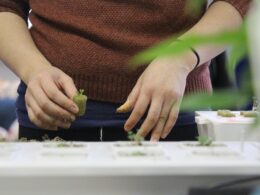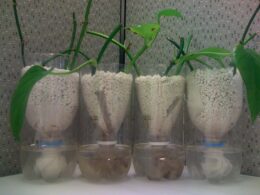Are you looking to start your own hydroponic garden and wondering what the best lettuce to grow is? Hydroponic gardening is a sustainable and efficient way to grow plants, especially in urban areas where space is limited.
Growing lettuce hydroponically offers many benefits, including higher yields, faster growth, and fewer pests and diseases. However, not all lettuce varieties are suitable for hydroponic gardening.
Choosing the right lettuce for your hydroponic system is crucial to ensure a successful harvest. In this article, we will discuss the characteristics of ideal hydroponic lettuce and the top varieties to grow. We will also provide tips and tricks for hydroponic lettuce gardening to help you get started on your own sustainable gardening journey.
Understanding Hydroponics
You’ll want to understand the basics of hydroponics before choosing the right type of plant to cultivate in your system. Hydroponics is a method of growing plants without soil, using only water and nutrients to provide the necessary elements for growth.
One of the benefits of hydroponic gardening is that plants grow faster and produce higher yields than traditional soil-based farming. However, there are some common mistakes to avoid in hydroponics. One of the biggest mistakes is overfeeding your plants with nutrients.
Unlike soil, water holds nutrients in a concentrated solution, so it’s easy to accidentally give your plants too much. This can lead to nutrient burn, where the excess minerals cause leaves to turn yellow or brown and eventually die.
To avoid mistakes and get the most out of your hydroponic system, be sure to do your research and follow instructions carefully. Start with a simple system and work your way up as you gain experience. With the right knowledge and care, you can grow a variety of plants hydroponically, including lettuce, herbs, and even fruit.
Characteristics of Ideal Hydroponic Lettuce
To optimize the growth and yield of your hydroponic lettuce, it’s important to consider specific characteristics that make a variety ideal for this method of cultivation. Here are four key features to look for when selecting your hydroponic lettuce:
-
Shorter growing cycle: A shorter growing cycle for the lettuce variety increases the chances of a higher yield in a hydroponic system. This means you can harvest more lettuce in a shorter amount of time.
-
Temperature control: Hydroponic lettuce grows best in temperatures between 60-70°F (15-21°C). Look for a lettuce variety that can tolerate these temperature ranges and does not require extreme temperature changes.
-
Compact size: Hydroponic systems have limited space for plant growth. Opt for a lettuce variety that is compact in size and takes up less space in the growing area.
-
Disease resistance: Since hydroponic systems are a closed environment, diseases can easily spread from one plant to another. Choose a lettuce variety that is resistant to common diseases that can affect hydroponic lettuce.
By selecting a lettuce variety that possesses these qualities, you can ensure a successful hydroponic lettuce harvest. Remember to maintain proper temperature control and follow a consistent growing cycle for optimal results.
Top Varieties of Lettuce for Hydroponic Gardening
If you want to maximize your hydroponic lettuce harvest, check out these top varieties that are perfect for cultivating in a closed environment. Choosing the right type of lettuce is crucial to ensure you get a high yield with maximum nutritional benefits. When selecting lettuce varieties, consider your taste preferences and the growth rates. Here are three of the best lettuce varieties to grow hydroponically:
First on the list is the Buttercrunch lettuce, which is a popular variety among hydroponic gardeners. This type of lettuce is known for its rich and buttery flavor, tender leaves, and crisp texture. It has a moderate growth rate and can be harvested within 50-60 days after planting. It produces a high yield and can be harvested multiple times throughout its growing cycle.
Next up is the Loose-leaf lettuce, which is a versatile variety that comes in different colors and shapes. It has a mild flavor and tender leaves that are perfect for salads and sandwiches. This type of lettuce has a fast growth rate and can be harvested within 30-45 days after planting. It also produces a high yield and can be harvested multiple times throughout its growing cycle.
Last but not least is the Romaine lettuce, which is a popular variety for its crunchy texture and slightly bitter taste. It has a longer growth cycle compared to other lettuce varieties, taking around 70-85 days to mature. However, it produces a high yield and can be harvested multiple times throughout its growing cycle. Romaine lettuce is also packed with nutrients such as vitamins A and C, making it an excellent addition to your daily diet.
By choosing the right lettuce varieties, you can ensure a bountiful harvest with maximum nutritional benefits. Keep in mind your taste preferences and the growth rates of each variety when selecting which lettuce to grow hydroponically. With these top varieties, you can enjoy fresh and healthy lettuce all year round.
Tips for Hydroponic Lettuce Gardening
Are you planning to start hydroponic lettuce gardening? To ensure your success, here are some tips that you need to keep in mind.
First, choose the right container that can provide enough space for your plants to grow.
Second, make sure to provide adequate light to promote healthy growth.
Lastly, manage your nutrient solution properly to ensure that your plants are getting the right amount of nutrients they need to thrive.
Choosing the Right Container
The container you choose will play a key role in the success of your hydroponic lettuce garden. Here are some tips to help you choose the right container:
-
Container materials: When choosing a container for your hydroponic lettuce garden, make sure that it’s made of food-safe materials such as plastic or glass. Avoid containers made of metals, as they can react with the nutrient solution and affect the pH levels.
-
Container size: The size of your container will depend on the number of lettuce plants you want to grow. Make sure that the container is deep enough for the roots to grow and has enough surface area to support the growth of the plants.
-
Drainage: Proper drainage is essential for the success of your hydroponic lettuce garden. Make sure that the container has drainage holes to allow excess water to escape.
-
Light exposure: Lettuce requires a lot of light to grow, so make sure that your container is placed in a location that receives enough sunlight or invest in grow lights to supplement the natural light.
Choosing the right container is crucial for the success of your hydroponic lettuce garden. By following these tips, you can ensure that your plants have the right environment to grow and thrive.
Providing Adequate Light
Providing enough light is crucial for the success of your hydroponic lettuce garden, so make sure to choose a location with ample sunlight or invest in grow lights to give your plants the boost they need. Lettuce requires about 14-16 hours of light per day to thrive, so it’s important to provide enough light to meet these requirements. When choosing a grow light, make sure to consider the light spectrum, as different wavelengths of light can affect plant growth in different ways. For lettuce, a full-spectrum LED grow light is a good choice, as it provides all the wavelengths of light that your plants need to grow and thrive.
To help you choose the right grow light for your hydroponic lettuce garden, here’s a table that outlines the lighting requirements and recommended light spectrum for lettuce:
| Lighting Requirements | Recommended Light Spectrum |
|---|---|
| 14-16 hours of light per day | Full-spectrum LED grow light |
| Intensity of 200-400 micromoles/m2/s | Blue and red light wavelengths |
Make sure to monitor the intensity of your grow light to ensure that your lettuce plants are receiving the right amount of light. With adequate lighting, your hydroponic lettuce garden will flourish and provide you with a bountiful harvest.
Nutrient Management
To keep your lettuce thriving in your hydroponic garden, you’ll need to manage the nutrient balance in your system. This means paying close attention to the pH balance of your water as well as choosing the right fertilizer options for your plants. Here are three things to keep in mind as you navigate nutrient management in your hydroponic lettuce garden:
-
pH balance is crucial: The pH level of your water will affect how well your plants are able to absorb nutrients. Ideally, you want your pH level to be between 5.5 and 6.5 for lettuce. You can use a pH testing kit to check your water regularly and make any necessary adjustments.
-
Choose the right fertilizer: There are a variety of fertilizer options available for hydroponic gardening, but not all of them are suitable for lettuce. Look for a fertilizer that is specifically formulated for hydroponic lettuce or for leafy greens in general. You’ll also want to pay attention to the nitrogen, phosphorus, and potassium levels in your fertilizer to make sure they are balanced for your plants.
-
Monitor nutrient levels: As your plants grow, they will consume nutrients from your water. It’s important to regularly monitor the nutrient levels in your system and make adjustments as needed to ensure your plants are getting everything they need to thrive. This may involve adding more fertilizer or adjusting the pH level of your water.
By keeping a close eye on your nutrient management, you can help ensure a bountiful harvest of delicious, healthy lettuce.
Conclusion and Next Steps
Now you have all the information you need to choose the perfect lettuce for your hydroponic garden and start enjoying fresh, crisp greens in no time. Before you get started, take a look at the table below to compare the top three lettuces for hydroponic growth:
| Lettuce Type | Optimal pH Range | Growth Time (Days) |
|---|---|---|
| Butterhead | 6.0-7.5 | 35-45 |
| Romaine | 6.0-7.0 | 60-70 |
| Looseleaf | 6.0-7.5 | 45-55 |
As you can see, each type of lettuce has its own optimal pH range and growth time. The Butterhead lettuce is the quickest to grow, while Romaine takes the longest. However, Romaine is more tolerant of lower pH levels. Looseleaf lettuce falls somewhere in between, with a moderate growth time and a pH range that overlaps with both Butterhead and Romaine.
Now that you have a better understanding of the different lettuce types and their optimal growing conditions, it’s time to take the next steps in setting up your hydroponic system. You may want to conduct further research on specific hydroponic techniques and equipment that will help you achieve the best possible results. Additionally, it’s important to consider the nutrient management aspect of hydroponic gardening, as proper nutrition is essential for healthy plant growth. With the right knowledge and tools, you can successfully grow fresh, delicious lettuce in your own home.
In summary, choosing the best lettuce for hydroponic growth involves considering factors such as pH range, growth time, and personal preferences. By referring to the table provided and conducting further research, you can make an informed decision on which type of lettuce to grow. Remember to also focus on nutrient management and explore different hydroponic techniques to optimize your harvest. With a little patience and dedication, you’ll soon be enjoying a bountiful supply of homegrown lettuce.
Frequently Asked Questions
What are the benefits of growing lettuce hydroponically compared to traditional soil-based methods?
If you’re looking for a way to grow lettuce that’s more efficient and sustainable than traditional soil-based methods, you might want to consider vertical farming with hydroponics.
This method of growing plants allows you to control the nutrients and environment of your crops, resulting in more consistent and higher quality yields.
Nutrient management is key in hydroponics, as the plants aren’t getting nutrients from soil, but rather from a solution that’s constantly circulated around their roots. This means you can optimize the amount of nutrients your lettuce receives, resulting in faster growth and healthier plants.
Plus, hydroponic systems use less water and space than traditional farming, making them an attractive option for those looking to maximize their resources.
How much space is needed to set up a hydroponic lettuce garden?
To maximize your yield in a hydroponic lettuce garden, it’s important to consider the space needed for vertical farming. With this method, you can grow more lettuce in a smaller area by stacking layers of plants on top of each other. This technique allows you to make the most of your space and increase your production.
When setting up your garden, be sure to choose a location that receives plenty of sunlight and has access to water and electricity. By utilizing vertical farming, you can create a thriving hydroponic lettuce garden with a high yield and minimal space requirements.
What equipment is required to start a hydroponic lettuce garden?
To start an indoor hydroponic lettuce garden, you’ll need a few key pieces of equipment.
First, you’ll need a nutrient solution to feed your plants, which can be purchased or made at home using sustainable farming techniques.
You’ll also need a growing container, such as a PVC pipe or plastic tote, and a pump to circulate the nutrient solution.
Additionally, you’ll need grow lights to simulate natural sunlight and a timer to regulate the light cycle.
With these items, you can easily set up your own indoor garden and enjoy fresh, sustainable lettuce year-round.
Can other vegetables or herbs be grown alongside lettuce in a hydroponic system?
Looking to expand your hydroponic garden beyond just lettuce? Companion planting is a great way to do so!
Many herbs can be grown alongside lettuce in a hydroponic system, such as basil, parsley, and mint. Not only do these herbs add flavor to your dishes, but they also provide natural pest control and can even improve the growth of your lettuce.
Hydroponic herbs like these are easy to grow and can thrive in the same nutrient-rich water as your lettuce. So why not try adding some herbs to your hydroponic garden today?
How often should the nutrient solution be changed in a hydroponic lettuce garden?
To keep your hydroponic lettuce garden healthy, it’s crucial to maintain a consistent nutrient solution. The frequency of nutrient changes depends on the size of your reservoir and the rate at which your plants consume nutrients.
Generally, it’s recommended to change your nutrient solution every two weeks to ensure that your plants receive the necessary nutrients. However, if you notice any signs of nutrient deficiencies or algae growth, it’s best to change the solution immediately.
It’s also important to use high-quality water to prevent any contaminants from harming your plants. Remember, the success of your hydroponic garden depends on the frequency of nutrient changes and the quality of your water.
Conclusion
Congratulations! You now have a good understanding of the best lettuce to grow hydroponically.
By choosing the right variety of lettuce and following the tips for hydroponic gardening, you can enjoy a bountiful harvest of fresh and healthy lettuce all year round.
Remember to choose lettuce varieties that are suited for hydroponic gardening such as butterhead, romaine, and loose-leaf lettuce. These varieties have the characteristics that make them ideal for hydroponic gardening such as fast-growing, disease-resistant, and high-yielding.
Also, don’t forget to maintain proper pH and nutrient levels, as well as adequate lighting and temperature for optimal growth. With these tips and tricks, you can be on your way to a successful hydroponic lettuce garden.









